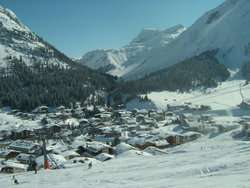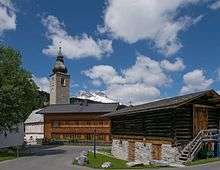Lech (Vorarlberg)
| Lech | |
|---|---|
 | |
 Lech Location within Austria | |
Location in the district
| |
| Coordinates: 47°12′00″N 10°09′00″E / 47.20000°N 10.15000°ECoordinates: 47°12′00″N 10°09′00″E / 47.20000°N 10.15000°E | |
| Country | Austria |
| State | Vorarlberg |
| District | Bludenz |
| Government | |
| • Mayor | Ludwig Muxel |
| Area | |
| • Total | 90 km2 (30 sq mi) |
| Elevation | 1,444 m (4,738 ft) |
| Population (1 January 2016)[1] | |
| • Total | 1,503 |
| • Density | 17/km2 (43/sq mi) |
| Time zone | CET (UTC+1) |
| • Summer (DST) | CEST (UTC+2) |
| Postal code | 6764 |
| Area code | 05583 |
| Vehicle registration | BZ |
| Website | www.gemeinde.lech.at |
Lech am Arlberg (Alemannic: Lääch) is a mountain village and an exclusive ski resort in the Bludenz district in the Austrian state of Vorarlberg on the banks of the river Lech. In terms of both geography and history, Lech belongs to the Tannberg district. In tourist terms, however, it is part of the Arlberg region. Lech is administered together with the neighbouring villages of Zürs, Zug, Oberlech and Stubenbach.
History
Lech was founded in the fourteenth century by Walser migrants from the canton of Wallis in Switzerland.
Until the nineteenth century it was known as Tannberg, but subsequently the full name "Tannberg am Lech" gave rise to the present name Lech.
The church of St Nicholas in Lech, which is thought to have been built in approximately 1390, was the parish church of the Tannberg administrative district, and there was also a Tannberg district court in Lech until the dissolution of the Tannberg district in 1806.
Population
| Historical population | ||
|---|---|---|
| Year | Pop. | ±% |
| 1869 | 436 | — |
| 1880 | 410 | −6.0% |
| 1890 | 371 | −9.5% |
| 1900 | 339 | −8.6% |
| 1910 | 352 | +3.8% |
| 1923 | 373 | +6.0% |
| 1934 | 751 | +101.3% |
| 1939 | 606 | −19.3% |
| 1951 | 681 | +12.4% |
| 1961 | 931 | +36.7% |
| 1971 | 1,223 | +31.4% |
| 1981 | 1,270 | +3.8% |
| 1991 | 1,234 | −2.8% |
| 2001 | 1,466 | +18.8% |
| 2011 | 1,627 | +11.0% |
Ski centre
In recent years Lech has grown to become one of the world's premier ski destinations and the home of a number of world and Olympic ski champions.
Lech is best known for its skiing (both on-piste and off-piste). It is well connected via mechanical lifts and groomed pistes with the neighbouring villages of Zürs, St Christof, St. Anton, Stuben, Warth and Schröcken, not least as a result of new lifts introduced for the 2013/14 and 2016/17 seasons, creating the largest connected ski area in Austria and one of the largest in Europe. Together these villages form the Arlberg region, the birthplace of the modern Alpine skiing technique and the seat of the Ski Club Arlberg. Lech is also the starting and finishing point for "Der Weisse Ring" ("The White Ring"), a circle of runs and lifts that is a popular tour and the scene of an annual race involving both experts and others.
Lech is a popular holiday destination for Royal families and celebrities, for example Tom Cruise, Diana, Princess of Wales, and the former Queen Beatrix and the Dutch Royal family.
The mountain holiday in the movie Bridget Jones' Diary 2 was shot in Lech.
Other attractions

Although not as well frequented in the summer as it is in the winter, Lech nevertheless has much to offer the summer visitor, in terms of sporting, cultural, culinary and other activities. There are many premier hotels in Lech, as well as numerous top class restaurants.
One former well-known visitor was the writer Ludwig Bemelmans (author of the Madeline books), whose 1949 novel "The Eye of God" was set in a fictionalised Lech.
Lech has a number of points of cultural interest, including:
- the church of St Nicholas, which was built in the gothic style in approximately 1390 and was extensively renovated in 1987. Particular features are the rococo interior dating from 1791 (although some earlier romanesque frescoes can also be seen); the 33 metre high tower with its distinctive onion-shaped dome; and bronze bells of which the oldest dates from the beginning of the sixteenth century
- the historic Huber House, now a museum, which was built in 1590 and shows examples of the earlier way of life and work, including the original kitchen and workshop
- life sized human sculptures by the sculptor Antony Gormley, which were placed in the mountains surrounding Lech, at an altitude of 2039 metres. Originally numbering 100, most were removed in April 2012, although some few still remain remain.
Notable residents
- Trudi Beiser, 1940s and 1950s Olympic skiing champion and World skiing champion
- Hans Wilhelm Hammerbacher (1903-1980), German author and Nazi
- Othmar Schneider, 1950s Olympic skiing champion
- Egon Zimmermann, 1960s Olympic skiing champion and World skiing champion
- Patrick Ortlieb, 1990s Olympic skiing champion and World skiing champion
- Herbert Jochum, Trainer of American Women's Olympic Ski Team (Zürs)
Sister cities
 Beaver Creek Resort, Avon, Colorado, United States of America
Beaver Creek Resort, Avon, Colorado, United States of America Kampen, Sylt, Germany
Kampen, Sylt, Germany Hakuba, Happo, Japan
Hakuba, Happo, Japan
References
External links
| Wikimedia Commons has media related to Lech (Vorarlberg). |
| Wikivoyage has a travel guide for Lech and Zürs am Arlberg. |
- Postcards from Lech
- Official web site of Lech am Arlberg
- Official Page of Lech am Arlberg
- Official Panoramic virtual tours of Lech
